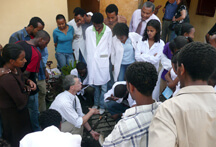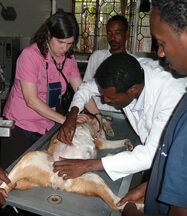
| RELATED INFO |
| * Purdue School of Veterinary Medicine home page |
| * Project Mercy home page |

July 14, 2009
Veterinary school celebrates 50 years with service project in Ethiopia
WEST LAFAYETTE, Ind. - |
The group spent several days working with Project Mercy, a U.S.-based nonprofit relief and development agency that seeks to improve both cattle and human nutrition through breeding practices.
"This trip was a service project first and foremost," said Mark Hilton, Purdue veterinarian and clinical professor of food and animal production medicine. "We knew we would be able to help out with Project Mercy and that they would appreciate any input we could provide."
As part of their work with Project Mercy, the group calculated animal weight, administered vaccines and performed pregnancy checks.
"The thing that surprised me most was the lack of adequate animal nutrition and growth," Hilton said. "The heifers there were only 250-350 pounds at a year old. Because of the lack of nutrition, animal reproduction is a luxury in Ethiopia. We saw 5-year-old heifers that had never even been in heat. We really want to improve reproduction and show the Ethiopian people that they can do it too."
One aspect of Project Mercy is breeding Ethiopian cattle breeds with American and European breeds, such as Jerseys—a breed of dairy cattle common in the United States.
 |
"Breeding Ethiopian cattle with Jerseys is a good fit because Jerseys are small, they have a high fertility rate and they produce a lot of milk," Hilton said.
In addition to the time spent on the Project Mercy campus, the Purdue team traveled to the Addis Ababa University College of Veterinary Medicine in Debre Zeyit, where they gave and listened to presentations and demonstrations.
"The trip to the veterinary school served as a way for us to establish a relationship between our program and theirs so we can continue to exchange ideas in the future," Hilton said. "We want to be able to keep sending our students, faculty and alumni over there, and we want their students and faculty to come to Purdue. It's a win-win situation for both universities."
Outside of the work they were doing, the Purdue team also had a chance for some cultural experiences, including a camping trip to Awash National Park and a tour of Genesis Farms, a large-scale organic produce and livestock operation.
"I had never been to Africa, and neither had many of our participants," said Mimi Arighi, Purdue veterinarian and director of the Veterinary Teaching Hospital. "You hear about the struggles, but to see it is hard. The electricity doesn't always work and they often run out of water, which hinders research. The computers are all on dial-up. It's just difficult to make advances."
One thing both Arighi and Hilton agreed upon was the enthusiasm of the Ethiopian people they met along the way.
"The people were just wonderful," Hilton said. "All of the kids yelled and waved when they saw us. They treated us like stars. They were so welcoming and seemed so happy we were there. It was obvious that they were thankful for any help we could provide them."
The Purdue School of Veterinary Medicine was established in 1959 with a class of 50 students. A veterinary technology degree program was added in 1975. The highly competitive doctor of veterinary medicine degree program now accepts approximately 70 students annually to study under 115 faculty members. Since its inception, the school has trained nearly 2,800 veterinarians and 800 veterinary technicians.
Writer: Jennifer Stewart, (765) 494-6682, jsstewar@purdue.edu
Sources: Mark Hilton, (765) 494-8559, hiltonw@purdue.edu
Becky Hershey, (765) 494-5032, bhershey@purdue.edu
Mimi Arighi, (765) 494-7235, arighi@purdue.edu
Ag Communications: (765) 494-8415;
Steve Leer, sleer@purdue.edu
Agriculture News Page
PHOTO CAPTION:
Mark Hilton, Purdue veterinarian and clinical professor of food and animal production medicine, explains to veterinary students in Ethiopia how to properly trim cow hooves. (Purdue University photo courtesy of Mimi Arighi)
https://www.purdue.edu/uns/images/+2009/hilton-ethiopia-hooves.jpg
PHOTO CAPTION:
Mary Grabow, veterinarian and alumnus of the Purdue School of Veterinary Medicine, assists an Ethiopian veterinary technician in preparing a dog to be spayed. Purdue University photo courtesy of Mimi Arighi)
https://www.purdue.edu/uns/images/+2009/grabow-ethiopia-spay.jpg
To the News Service home page
